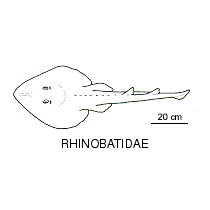- Classification
- CHONDRICHTHYES
- RHINOPRISTIFORMES
- RHINOBATIDAE
-
Fish Classification
-
Class
CHONDRICHTHYES Sharks, rays ... -
Order
RHINOPRISTIFORMES Guitarfishes -
Family
RHINOBATIDAE Guitarfishes -
Genera
Rhinobatos(1)
Family RHINOBATIDAE
Guitarfishes have a flattened body, a narrow to broadly triangular snout forming a flattened disc with the large angular or rounded pectoral fins, a robust tail with two well-developed dorsal fins and a prominent shark-like caudal fin. The elongate snout has a median cartilaginous support.
More Info
|
Family Taxonomy |
About 48 species of guitarfishes in five genera are currently recognized worldwide. Eight species in four genera are known from Australian waters (Eschmeyer & Fong, 2012). |
|
Family Distribution |
Guitarfishes are benthic in shallow tropical to temperate marine waters worldwide, and some species occasionally enter estuaries and freshwater. |
|
Family Description |
Although rather flattened with a ventral mouth, the tail is thick, carries two dorsal fins and one caudal fin and lacks venomous spines. |
|
Family Size |
Maximum size is almost 3 m. |
|
Family Feeding |
Guitarfishes are carnivores, and feed on fishes and a range of benthic invertebrates including crustaceans and molluscs. |
|
Family Reproduction |
Guitarfishes have an ovoviparous mode of reproduction. The embryos develop inside eggs and hatch within the mother before they are born live and fully developed. |
|
Family Commercial |
Commercially fished in parts of their range. |
|
Family Conservation |
The IUCN (International Union for the Conservation of Nature) Redlist status has been evaluated for many species in the family Rhinobatidae. IUCN |
|
Author |
Bray, D.J. 2017 |
References
Bigelow, H.B. & Schroeder, W.C. (1953). Sawfishes, guitarfishes, skates and rays. in Parr, A.E. (ed.) Fishes of the Western North Atlantic. Mem. Sears Fndn. Mar. Res. 1(2): 1–514 figs 1–117.
Compagno, L.J.V. & Hamlett, W.C. (eds). 1999. Checklist of Living Elasmobranchs. Sharks, Skates, and Rays: The Biology of Elasmobranch Fishes. 471-498
Compagno, L.J.V. & Last, P.R. (1999). Families Pristidae, Rhinidae, Rhinobatidae, Platyrhinidae. pp. 1410–1432 in Carpenter, K.E. & Niem, V.H. (eds) The Living Marine Resources of the Western Central Pacific. FAO Species Identification Guide for Fisheries Purposes. Rome : FAO Vol. 3 pp. 1397–2068
Eschmeyer, W.D. & J.D. Fong. 2012. Species of Fishes by family/subfamily. On-line version dated 15 March 2012. http://research.calacademy.org/research/ichthyology/catalog/SpeciesByFamily.asp
Fowler, H.W. (1941). Contributions to the biology of the Philippine Archipelago and adjacent regions. The fishes of the groups Elasmobranchii, Holocephali, Isospondyli and Ostariophysi obtained by the United States Bureau of Fisheries Steamer Albatross in 1907 to 1910, chiefly in the Philippine Islands and adjacent seas. Bull. U.S. Natl. Mus. 100(13): 1–879 figs 1–30
Last, P.R. & Séret, B.. 2016. 12 Banjo Rays Family Trygonorrhinidae (pp. 117-126), in Last, P.R., White, W.T., de Carvalho, M.R., Séret, B., Stehmann, M.F.W. & Naylor, G.J.P. (eds) Rays of the World. Melbourne : CSIRO Publishing, 800 pp.
Moore, A.B.M. 2017. Are guitarfishes the next sawfishes? Extinction risk and an urgent call for conservation action. Endangered Species Research 34: 75–88 https://doi.org/O/esr00830 PDF available, open access



